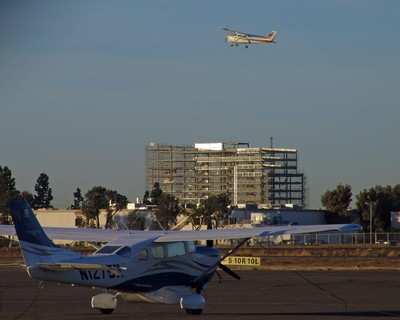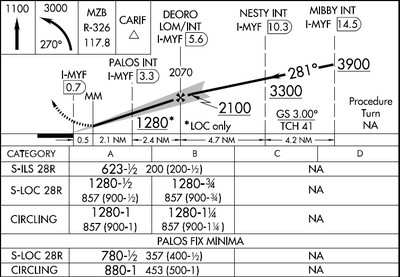Agency Says Construction Project Is 20 Feet Too Tall
The city of San Diego has given a developer the go ahead to put
the roof on a building which is the center of a dispute between the
developer, the FAA and the California Department of
Transportation (Caltrans).

The San Diego Union-Tribune reports the 12-story building, a new
construction project just north of Montgomery Field's boundary
area, will be 180 feet tall when complete. According to the FAA,
anything over 160 feet in that location will pose a hazard to air
traffic at the airport.
As ANN reported, the city
ordered the developer, Sunroad Enterprises, to cease construction
early last November when it became aware the building might be too
tall. The FAA and Caltrans had informed Sunroad last spring
the completed building would be too tall, and Sunroad initially
agreed to meet the FAA's 160-foot restriction. Two months
later, however, the developer submitted a new plan showing the
building to be 180 feet.
Perhaps not by coincidence, Sunroad had already framed the top
two floors before submitting its new plan. Neither the FAA nor
Caltrans has the authority to halt construction, since the project
is outside the airport boundary. That's when the city forced the
company to cease building while the situation was sorted out.
The FAA says that while the building sits outside the airport
boundary, it also sits right in the path of IFR traffic circling to
land on runways 23, 10L and 10R. The only published instrument
procedures for the airport are to runway 28R. If winds or a runway
closure were to require a landing on runways 23, 10L or 10R, a
pilot must fly the procedure to 28R and circle to another runway
after descending to minimums. Pilots circling to the north would
fly very near -- if not directly over -- the new building in the
process. Aircraft capable of identifying the PALOS intersection on
the approach are allowed to descend to 453 AGL while circling.

A lawsuit filed last month by the City Attorney's office, and joined last week by AOPA and a group
of local pilots and airport users, demands Sunroad
remove the top two floors of the building to bring it into
compliance with the FAA's restrictions.
Additionally, Caltrans is pursuing its own legal options. It
says Sunroad failed to apply for the proper permits required of any
project that doesn't comply with FAA standards. State and city
attorneys are said to be working on a joint strategy and
are seeking an expedited court date.
The city's decision to allow workers to add the roof comes after
Sunroad warned the top two floors it had framed up will suffer
damage from rain if the building sits too much longer. The
city allowed Sunroad to add the roof at its own risk -- but San
Diego warned Sunroad the city won't be held liable if the suit is
successful and Sunroad is eventually forced to remove the top two
floors.

Sunroad maintains it has done nothing to jeopardize air safety.
It says the building is not a hazard and that the lawsuit is
sensationalizing the issue. In a statement, the company said,
"Sunroad Enterprises is fully committed to public safety, and we
would not have built the building if it was a public-safety
hazard."
Exactly what qualification the company has to make such a
determination is unclear.
In a seeming bit of double-talk, Sunroad has offered to fund the
necessary navigation equipment to allow a straight-in approach
to runway 23, thus obviating the need for circling approaches. That
leads one to wonder why a straight-in approach to 23 would be
necessary if there's no hazard to circling IFR traffic? In any
event, the FAA says studying the impact of a new approach on
traffic at nearby Miramar Marine Corps Air Station could take as
long as a year.
So far, the FAA hasn't changed the approach procedures to
reflect any restrictions on circling approaches at Montgomery
field. Caltrans has warned Sunroad will be held liable for any
accidents that might result from the building's height.
Of course, that would be of little comfort to a pilot or
passenger involved in such an accident...
 ANN's Daily Aero-Term (12.14.25): Local Airport Advisory (LAA)
ANN's Daily Aero-Term (12.14.25): Local Airport Advisory (LAA) Airborne 12.08.25: Samaritans Purse Hijack, FAA Med Relief, China Rocket Fail
Airborne 12.08.25: Samaritans Purse Hijack, FAA Med Relief, China Rocket Fail ANN's Daily Aero-Linx (12.15.25)
ANN's Daily Aero-Linx (12.15.25) Airborne 12.10.25: New Gulfstream, ATC Integrator, Outrageous FFZ User Fees
Airborne 12.10.25: New Gulfstream, ATC Integrator, Outrageous FFZ User Fees Airborne-NextGen 12.09.25: Amazon Crash, China Rocket Accident, UAV Black Hawk
Airborne-NextGen 12.09.25: Amazon Crash, China Rocket Accident, UAV Black Hawk





